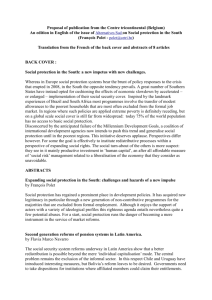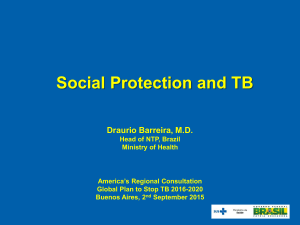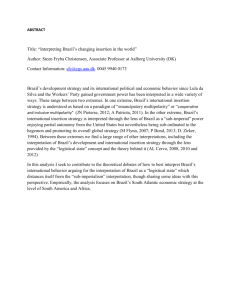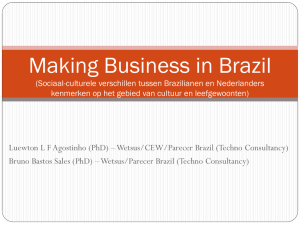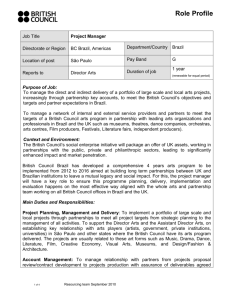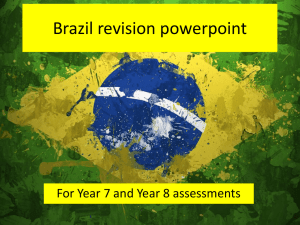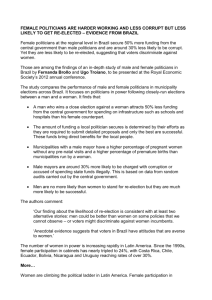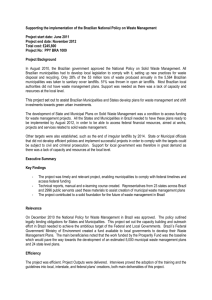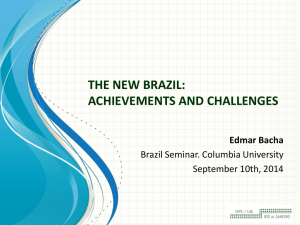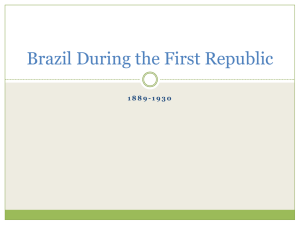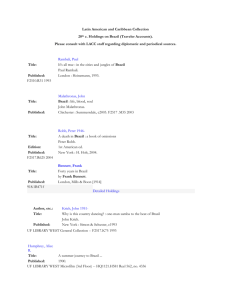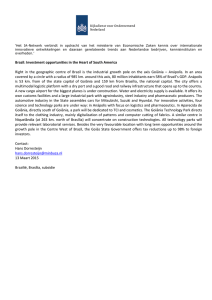SOCIAL ISSUES IN BRAZIL
advertisement
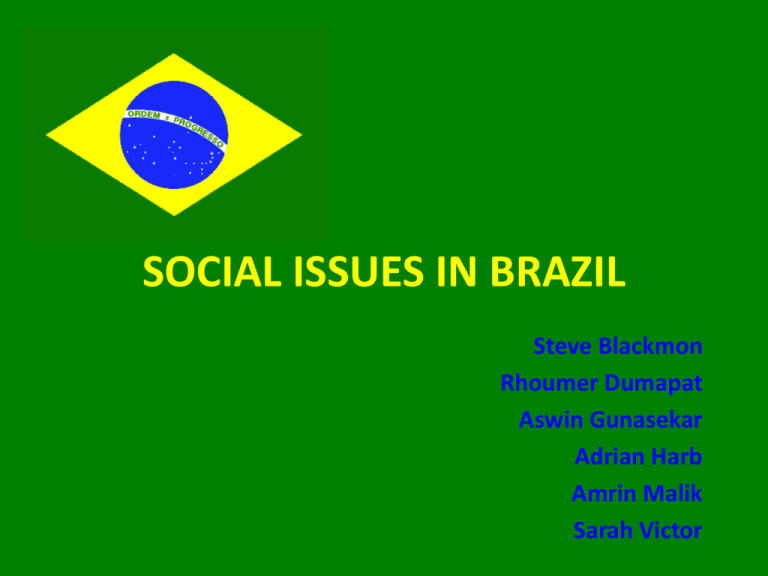
SOCIAL ISSUES IN BRAZIL Steve Blackmon Rhoumer Dumapat Aswin Gunasekar Adrian Harb Amrin Malik Sarah Victor SOCIAL ISSUES IN BRAZIL • Pobreza • Questões raciais • Gangues/Drogas • Educacao SOCIAL ISSUES IN BRAZIL • Pobreza (Poverty) • Questões raciais (Racial Issues) • Gangues/Drogas (Youth gangs and drugs) • Educacao (Education) RACE & ETHNICITY IN BRAZIL • Indigenous populations: Tupi, Ewe, and Ge • 1500’s: Portuguese Settlers and African populations • Late 1800’s – 1900’s: Italian, Spanish, German, Japanese, Middle East, and Eastern Europe • Sugar cane crops, gold and diamonds = increased slave trafficking • Last country in the Americas to end slavery (1888) SOCIAL APARTHEID Indicators White Brazilian Black Brazilian Illiteracy 5.9% 13.3% University Degree 15.0% 4.7% Life Expectancy 73.13% 67.03% Unemployment 5.7% 7.1% GDP Per Capita R$ 22,699 R$ 15,068 29% 65.5% Homicide Deaths THE FUTURE POVERTY • • Most visually represented by Favelas In part attributed to economic inequality • • • • > 50% of population lacks resources for basic survival Poor segment is 33% of population. Extremely poor is 13% Richest 10% receive 42% of nation's income Poorest population receives < 1.2% of nation’s income GINI COEFFICIENT 0 perfect income equality 1 maximal inequality Gini-coefficient of national income distribution around the world (using 2009 info) POVERTY MITIGATION & OUTLOOK • Fight extreme poverty and income inequality – Public policies of social intervention – Increased social spending (21.9% in 2005) – Decentralization of social policy • Municipalities share of social spending rose 53.8% from 1980 to 2008 – ‘Zero Hunger’ program – ‘Bolsa Familia’ • Reach social indicators of developed countries by 2016 – Projected poverty rate of 4% YOUTH GANGS & DRUGS • Drug gangs control majority of favelas around cities. • Gangs recruit children as young as 10 to run/sell drugs. • Kids can earn up to $150/day. Brazil US YOUTH PROGRAMS & EDUCATION • Locally/internationally sponsored youth programs are helping break the low poverty/education cycle. • +Oportunidades program is preparing kids for a brighter future through education and training. REVIEW OF THE EDUCATION SYSTEM • Primary Education • Free for all • Most elementary schools maintained by municipalities or the States • Richer cities have better schools due to better tax revenue • Biggest problem is non attendance due to malnutrition, children working and high examination failure rate • Standards falling, middle class turn to private schools further making public schools worse • Official programs that have worked well: Bolsa Escola; now rolled into Bolsa Familia, FUNDEF SECONDARY EDUCATION • Not mandatory in Brazil • Most intermediary schools are maintained by the municipalities and States • Access to University based mainly on merit, measured by performance in ENEM (previously called 'vestibular’) • Private schools prepare students better for University • Students who could afford the best intermediary schools or cursinhos approved into the free public universities • Inherent handicap for poor students HIGHER EDUCATION • Majority of federal education funds goes towards public universities • Better lobbying power • Public universities are best in quality 1. 2. 3. Universidade Federal do Rio de Janeiro Universidade de São Paulo Universidade de Brasília • Have funds needed for investments in Medicine and Engineering programs • Private universities offer Human Sciences, Administration, Accounts OUTLOOK • Some notable successes – 700,000 scholarships for low income students – 180 vocational schools compared to 140 and 93 over that last 2 years – School enrollments climbing, Middle school graduation rate risen from 34% to 47% • Yet, Education - the biggest disadvantage for Brazil compared to China, India & Russia – More than 22 percent of the roughly 25 million workers available to join Brazil’s work force in 2011 were not considered qualified to meet the demands of the labor market • Many parents say, ‘Why should they study if there are no opportunities?’ • ‘Unless that gap is filled soon, Brazil may miss its demographic window over the next two decades in which the economically active population is at its peak’ - World Bank OBRIGADO!


